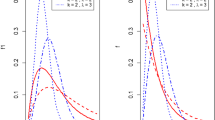Abstract
Trimmed samples are commonly used in several branches of statistical methodology, especially when the presence of contaminated data is suspected. Assuming that certain proportions of the smallest and largest observations from a Weibull sample are unknown or have been eliminated, a Bayesian approach to point and interval estimation of the scale parameter, as well as hypothesis testing and prediction, is presented. In many cases, the use of substantial prior information can significantly increase the quality of the inferences and reduce the amount of testing required. Some Bayes estimators and predictors are derived in closed-forms. Highest posterior density estimators and credibility intervals can be computed using iterative methods. Bayes rules for testing one- and two-sided hypotheses are also provided. An illustrative numerical example is included.
Similar content being viewed by others
References
Abernethy RB (1998) The new Weibull handbook. Published by Robert B. Abernethy, North Palm Beach, FL
Bernardo JM (1980) A Bayesian analysis of classical hypothesis testing. Bayesian statistics. In: Bernardo JM, De Groot MH, Lindley DV, Smith AFM (eds) Proceedings of the first international meeting, Valencia (Spain). Valencia University Press
Bernardo JM, Smith AFM (1994) Bayesian theory. Wiley, New York
Bhattacharyya GK (1985) On asymptotics of maximum likelihood and related estimators based on Type II censored data. J Am Statist Assoc 80:398–404
Carlin B, Louis T (1996) Bayes and empirical Bayes methods for data analysis. Chapman and Hall, London
Fernández AJ (2006) Bayesian estimation based on trimmed samples from Pareto populations. Comput Statist Data Anal 51:1119–1130
Harris CM, Singpurwalla ND (1968) Life distributions derived from stochastic hazard functions. IEEE Trans Reliab 17:70–79
Healy MJR (1982) Algorithm AS 180: A linear estimator of standard deviation in symmetrically trimmed normal samples. Appl Statist 31:174–175
Huber PJ (1981) Robust statistics. Wiley, New York
Ibrahim JG, Chen M-H, Sinha D (2001) Bayesian survival analysis. Springer, New York
Jeffreys H (1961) Theory of probability. Oxford University Press, Oxford
Klinger DJ, Nakada Y, Menéndez MA (1990) AT&T reliability manual. Van Nostrand Reinhold, New York
Lindley DV (1965) Introduction to probability and statistics from a Bayesian viewpoint. Part 2: Inference. C.U.P., Cambridge
Martz HF, Waller RA (1982) Bayesian reliability analysis. Wiley, New York
Meeker WQ, Escobar LA (1998) Statistical methods for reliability data. Wiley, New York
Moore AH, Bilikam JE (1978) Bayesian estimation of parameters of life distributions and reliability from type II censored samples. IEEE Trans Reliab 27:64–67
Nordman DJ, Meeker WQ (2002) Weibull prediction intervals for a future number of failures. Technometrics 44:15–23
Prescott P (1978) Selection of trimming proportions for robust adaptive trimmed means. J Am Statist Assoc 73:133–140 (Correction: 73:691)
Sarhan AE, Greenberg BG (1962) Contributions to order statistics. Wiley, New York
Soland RM (1968) Bayesian analysis of the Weibull process with unknown scale parameter and its application to acceptance sampling. IEEE Trans Reliab 17:84–90
Soland RM (1969) Bayesian analysis of the Weibull process with unknown scale and shape parameter. IEEE Trans Reliab 18:181–184
Tsokos CP, Canavos GC (1972) Bayesian concepts for the estimation of reliability in the Weibull life testing model. Int Statist Rev 40:153–160
Tsokos CP, Rao ANV (1976) Bayesian analysis of the Weibull failure model under stochastic variation of the shape and scale parameters. Metron 34:201–217
Welsh AH (1987) The trimmed mean in the linear model (with discussion). Ann Statist 15:20–45
Wilcox RR (1995) Simulation results on solutions to the multivariate Behrens-Fisher problem via trimmed means. The Statistician 44:213–225
Zhang Y, Meeker WQ (2005) Bayesian life test planning for the Weibull distribution with given shape parameter. Metrika 61:237–249
Author information
Authors and Affiliations
Corresponding author
Rights and permissions
About this article
Cite this article
Fernández, A.J. Weibull inference using trimmed samples and prior information. Stat Papers 50, 119–136 (2009). https://doi.org/10.1007/s00362-007-0067-2
Received:
Revised:
Published:
Issue Date:
DOI: https://doi.org/10.1007/s00362-007-0067-2



